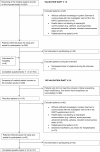Drug-Associated Risk Tool: development and validation of a self-assessment questionnaire to screen for hospitalised patients at risk for drug-related problems
- PMID: 29523558
- PMCID: PMC5855403
- DOI: 10.1136/bmjopen-2017-016610
Drug-Associated Risk Tool: development and validation of a self-assessment questionnaire to screen for hospitalised patients at risk for drug-related problems
Abstract
Introduction: Identifying patients with a high risk for drug-related problems (DRPs) might optimise the allocation of targeted pharmaceutical care during the hospital stay and on discharge.
Objective: To develop a self-assessment screening tool to identify patients at risk for DRPs and validate the tool regarding feasibility, acceptability and the reliability of the patients' answers.
Design: Prospective validation study.
Setting: Two mid-sized hospitals (300-400 beds).
Participants: 195 patients, exclusion criteria: under 18 years old, patients with a health status not allowing a meaningful communication (eg, delirium, acute psychosis, advanced dementia, aphasia, clouded consciousness state), palliative or terminally ill patients.
Methods: Twenty-seven risk factors for the development of DRPs, identified in a previous study, provided the basis of the self-assessment questionnaire, the Drug-Associated Risk Tool (DART). Consenting patients filled in DART, and we compared their answers with objective patient data from medical records and laboratory data.
Results: One hundred and sixty-four patients filled in DART V.1.0 in an average time of 7 min. After a first validation, we identified statements with a low sensitivity and revised the wording of the questions related to heart insufficiency, renal impairment or liver impairment. The revised DART (V.2.0) was validated in 31 patients presenting heart insufficiency, renal impairment or liver impairment as comorbidity and reached an average specificity of 88% (range 27-100) and an average sensitivity of 67% (range 21-100).
Conclusions: DART showed a satisfying feasibility and reliability. The specificity of the statements was mostly high. The sensitivity varied and was higher in statements concerning diseases that require regular disease control and attention to self-care and drug management. Asking patients about their conditions, medications and related problems can facilitate getting a first, broad picture of the risk for DRPs and possible pharmaceutical needs.
Keywords: drug-related problems; risk management; self-assessment questionnaire.
© Article author(s) (or their employer(s) unless otherwise stated in the text of the article) 2018. All rights reserved. No commercial use is permitted unless otherwise expressly granted.
Conflict of interest statement
Competing interests: None declared.
Figures



Similar articles
-
Assessing the ability of the Drug-Associated Risk Tool (DART) questionnaire to stratify hospitalised older patients according to their risk of drug-related problems: a cross-sectional validation study.BMJ Open. 2018 Jun 27;8(6):e021284. doi: 10.1136/bmjopen-2017-021284. BMJ Open. 2018. PMID: 29950469 Free PMC article.
-
Development of a Predictive Model for Drug-Related Problems in Kidney Transplant Recipients.Pharmacotherapy. 2017 Feb;37(2):159-169. doi: 10.1002/phar.1886. Epub 2017 Feb 3. Pharmacotherapy. 2017. PMID: 27997676
-
Drug-related problems identified by pharmacist-led medication review in Slovak hospitalised patients.Pharmazie. 2016 Sep 1;71(9):548-551. doi: 10.1691/ph.2016.5760. Pharmazie. 2016. PMID: 29441854
-
Medical care and drug-related problems: Do doctors and pharmacists speak the same language?Int J Clin Pharm. 2016 Apr;38(2):191-4. doi: 10.1007/s11096-016-0249-x. Epub 2016 Jan 21. Int J Clin Pharm. 2016. PMID: 26797769 Review.
-
[Medication review in older people: identification of a new risk group].Ned Tijdschr Geneeskd. 2015;159:A8929. Ned Tijdschr Geneeskd. 2015. PMID: 25990336 Review. Dutch.
Cited by
-
Screening Tools Used by Clinical Pharmacists to Identify Elderly Patients at Risk of Drug-Related Problems on Hospital Admission: A Systematic Review.Pharmacy (Basel). 2020 Apr 10;8(2):64. doi: 10.3390/pharmacy8020064. Pharmacy (Basel). 2020. PMID: 32290347 Free PMC article. Review.
-
The doMESTIC RISK Tool: Prioritising Home-Care Patients for Clinical Pharmacy Services with the Help of a Delphi Study.Nurs Rep. 2025 May 1;15(5):158. doi: 10.3390/nursrep15050158. Nurs Rep. 2025. PMID: 40423192 Free PMC article.
-
Assessing the ability of the Drug-Associated Risk Tool (DART) questionnaire to stratify hospitalised older patients according to their risk of drug-related problems: a cross-sectional validation study.BMJ Open. 2018 Jun 27;8(6):e021284. doi: 10.1136/bmjopen-2017-021284. BMJ Open. 2018. PMID: 29950469 Free PMC article.
-
Enhancing the clinical pharmacy service of a large teaching hospital: Development of a new clinical prioritisation tool.Explor Res Clin Soc Pharm. 2023 Sep 21;12:100335. doi: 10.1016/j.rcsop.2023.100335. eCollection 2023 Dec. Explor Res Clin Soc Pharm. 2023. PMID: 37790885 Free PMC article.
-
"Doctor, would it surprise you if there were prescribing errors in this patient's medication?" Identifying eligible patients for in-hospital pharmacotherapeutic stewardship: A matched case-control study.Br J Clin Pharmacol. 2025 Mar;91(3):789-798. doi: 10.1111/bcp.16253. Epub 2024 Oct 17. Br J Clin Pharmacol. 2025. PMID: 39419636 Free PMC article.
References
-
- Pharmaceutical Care Network Europe (PCNE). The definition of drug-related problems. 2009. http://www.pcne.org/sig/drp/drug-related-problems.php (accessed 10 Nov 2016).
-
- Krähenbühl-Melcher A, Schlienger R, Lampert M, et al. . Drug-related problems in hospitals: a review of the recent literature. Drug Saf 2007;30:379–407. - PubMed
Publication types
MeSH terms
LinkOut - more resources
Full Text Sources
Other Literature Sources
Medical
